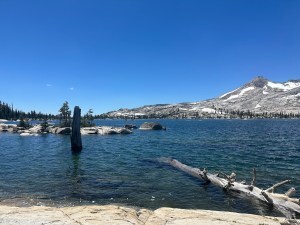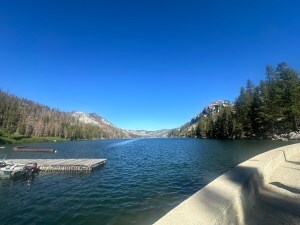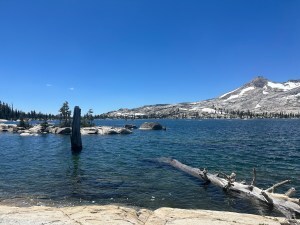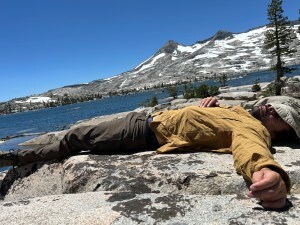Day 16: Desolation Wilderness

One of my greatest regrets is that I didn’t take fuller advantage of the outdoors while living in California. To be fair, I was under tremendous pressure during these years, competing my PhD and working a demanding government innovation job while raising three young kids. We did the best we could with the outdoors, which was still respectable: frequent trips to northern California’s many beaches, a few ski trips to Tahoe, day hikes, summer vacations at alpine lakes, and a couple backpacking trips. Yet I craved more: more wilderness, more nights under the stars, more epic adventures.
When the COVID-19 pandemic hit, and California began enforcing strict lockdowns, I suggested spending long stretches of time in the mountains, Captain Fantastic-style. While most Californians were huddled at home, the national parks and forests would be practically empty. We could homeschool our kids, teach them wilderness survival and first aid skills, and explore some of the world’s most beautiful places, all while complying with social distancing legislation. My target for this mountain fantasy was Desolation Wilderness, southwest of Lake Tahoe, a place I had only heard of. The name alone was enough to evoke wonder.
My family quite didn’t share my enthusiasm, and rapidly-evolving government policy left us unsure whether this would even be legal. I let the fantasy go.
—When we live in a place, we take it for granted. This seems to be a universal element of the human condition. We travel the world to see a destination’s most famous sights, but many of us sheepishly confess that we’ve never visited the sights in our own backyards.
Moving to Alabama from California felt like exile. I made a nice life for myself, but I yearned for West Coast beauty. I appreciated the Southern mountains for what they were, but I knew the truth: they were only hills. I pined for the mountains and escaped when I could, on brief trips to the Sierra, the Tetons, and Red Rock National Park. I also sought the wilderness in books.
This trip has finally given me the opportunity to return to California, this time as a visitor. I resolved to not take the mountains for granted. I would have abundant time to revel in the beauty and truly learn each destination we visited.
I prepared for the trip with books. First and foremost was Kim Stanley Robinson’s High Sierra: A Love Story. I’d first discovered Robinson while a cadet at the U.S. Air Force Academy. I attended a conference about sending a manned spacecraft to Mars, where he was a keynote speaker. He won me over immediately: a sophisticated science fiction author, deeply intellectual, clearly brilliant, lean and handsome, and reportedly a mountain climber. I bought and read Red Mars, his most famous book, and then all the rest of his novels. He was unlike any other science fiction author I’d read. His work showed a deep love of nature. Unlike many SF authors, he seemed enchanted with this world, and he took that love into his science fiction settings.
High Sierra is a significant departure from his science fiction. It defies genre, combining personal memoir with mini lessons in geology, essays on the naming of wilderness features, sketches of key figures in Sierra history, and wilderness travel tips. Robinson writes that his own love affair with the Sierra began in the Desolation Wilderness in the 1970s, which only doubled down on my determination to visit. Hannah, who loved the book as much as I did, agreed we needed to go.
—We planned to visit Desolation Wilderness earlier in our trip, but it became a casualty of our finite schedule. Now that we’re back in Truckee, we thankfully have another opportunity. Mallory, an old friend of Hannah’s we want to spend time with, suggests a hike.
 The hike runs roughly six miles, from Echo Lake to Lake Aloha, and then six miles back again. It begins in an overflowing parking lot, where we are exceptionally lucky to nab a spot from a departing vehicle; later, when we return, we find citations on the windshields of dozens of vehicles crammed along the roads. From the parking lot, a road leads down to a bustling store and boat launch. Friendly trail volunteers issue us a permit, then we set off along the shore of the lake.
The hike runs roughly six miles, from Echo Lake to Lake Aloha, and then six miles back again. It begins in an overflowing parking lot, where we are exceptionally lucky to nab a spot from a departing vehicle; later, when we return, we find citations on the windshields of dozens of vehicles crammed along the roads. From the parking lot, a road leads down to a bustling store and boat launch. Friendly trail volunteers issue us a permit, then we set off along the shore of the lake.
We aren’t actually in Desolation Wilderness yet; this hike begins in civilization and climbs its way out. The lake is teeming with recreational boaters. The trail passes dozens of small lakefront cabins, accessibly only by boat or trail. Vacationing families sit on patios, listening to loud music, talking. The trail is packed, a wilderness highway. It’s the kind of hike that I suspect Kim Stanley Robinson would avoid.
Still, the scenery is beautiful, and I don’t mind crowded trails. Seeing people outdoors makes me happy. When we pause to filter water, a delightful woman from a huge Korean group shares her childhood memories of drinking unfiltered water from sparkling creeks. We pass a boy scout troop, backpackers lugging heavy packs, and a group toting snowboards and skis in search of shady slopes still packed with snow.
 Past the lake, we start a steep climb to a ridge. At last we reach the top and then the wilderness on the other side. The beauty keeps unfurling. The trail flattens and winds through alpine meadows. Snowmelt is pooled in dozens of unnamed ponds.
Past the lake, we start a steep climb to a ridge. At last we reach the top and then the wilderness on the other side. The beauty keeps unfurling. The trail flattens and winds through alpine meadows. Snowmelt is pooled in dozens of unnamed ponds.
Then, suddenly, we get our first glimpse of Lake Aloha. I had no expectations for this hike, but the vista is literally stunning. I stop to take it in: a black-and-white painting, white snow on bright granite, the broken white trunks of pines. This grayscale landscape makes the crystalline blue lake all the more brilliant, like a partially colorized photo.
 The lake houses a backcountry campground. Brightly colored tents are wedged into every open space among the trees. Camp stoves and pots sit on tables improvised from chopped logs. Bear canisters lay about. Hikers and backpackers are sunning themselves on the rocks or swimming in the glacial water.
The lake houses a backcountry campground. Brightly colored tents are wedged into every open space among the trees. Camp stoves and pots sit on tables improvised from chopped logs. Bear canisters lay about. Hikers and backpackers are sunning themselves on the rocks or swimming in the glacial water.
We dump our daypacks on a rock, eat lunch, and drink warm beer. The sun, breeze, and alcohol make me sleepy. I nap while the women talk. Mallory takes a plunge in the lake. It’s tempting, but I’m feeling happily lazy. Eventually we rouse ourselves, gather our belongings, and start the hike back.
—Literature and nature, my two great loves. It feels wonderful to combine them on this trip. Books bring places to life, and I love visiting places special to authors. Hannah and I often make references to “Stan”, as though Kim Stanley Robinson is our personal guide, who has somehow wandered off and left us. Every time one of us wonders about some unique geological feature, the other says, “We need Stan.” Little references to the book pepper our conversations.
As we descend, our journey into wilderness reverses itself: back to the crowds, to the lakeside rentals, to speedboats and stand up paddlers. At the lakeside store we buy popsicles, then make the long drive back to Truckee.
It was a reasonably long hike, but it offered little more than a glimpse of Desolation Wilderness. We would need days or weeks to properly experience this place. Maybe a lifetime. And if Kim Stanley Robinson is right, this isn’t even the prettiest place in the Sierra. But at least we were here, seeing it for ourselves, sampling the riches it offers. I remind myself that this doesn’t need to be my last trip. I am taking notes about where I want to return, hopefully with my kids.
Day after day, this trip reminds me: take nothing for granted. Experience everything. There is so much life to be had.



